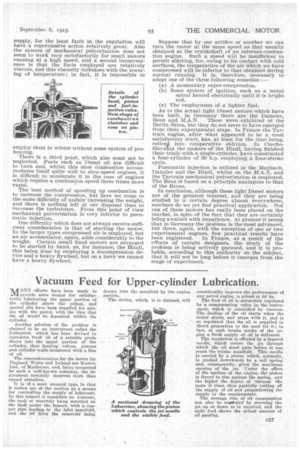Vacuum Feed for Upper-cylinder Lubrication.
Page 11

If you've noticed an error in this article please click here to report it so we can fix it.
Ar ANY efforts have been made to .111.provide some means for satisfactorily lubricating the upper portion of the cylinder above the piston, and special oils have been supplied for mixing with the petrol, with the idea that the oil would he deposited within the cylinder.
Another solution of the problem is claimed to be an instrument called the Luburetor, which has been devised to introduce fresh :oil of a suitable grade direct into the upper portion of 'the cylinder, thus keeping valves, pistons and cylinder-walls moistened with a film of oil.
The concessionnaires for the device for England. Wales and Ireland are Routes, Ltd., of Maidstone, and, being sponsored by such a well-known company, the instrument certainly deserves more than casual attention.
It is of a most unusual type, in that it makes use of the suction as a means for controlling the supply of lubricant. In this respect it resembles an Autovac, the tank or reservoir being mounted on the dash under the bonnet, with a copper pipe leading to the inlet manifold, and the oil from the reservoir being drawn into the manifold by the engine
.suctiOn.
The device, which, it is claimed, will considerably improve the performance of any petrol engine, is priced at £4 4s.
The feed of oil is accurately regulated by a compensating valve in the instrument, .which is controlled by vacuum. The feeding of the oil starts when the motor starts, and stops with it, and is so regulated that the oil is supplied in direct proportion to the need for it ; in fact, at each intake stroke of the engine a fresh supply of oil is delivered.
The regulation is effected by a tapered needle, which enters the jet through which the oil must pass before it can reach the intake manifold. This needle is carried by a piston which, normally, is pushed downwards by a coil spring and, consequently, gives the maximum opening of the jet. Under the effect of the suction of the engine, the piston is forced to rise against the spring, and the higher the degree of vacuum the more it rises, thus partially cutting off the supply of oil and proportioning the supply to the requirements.
The average rate of oil consumption can also be rege4. ated by screwing the jet up or down as is required, and the sight feed shows the actual amount of oil passing.






























